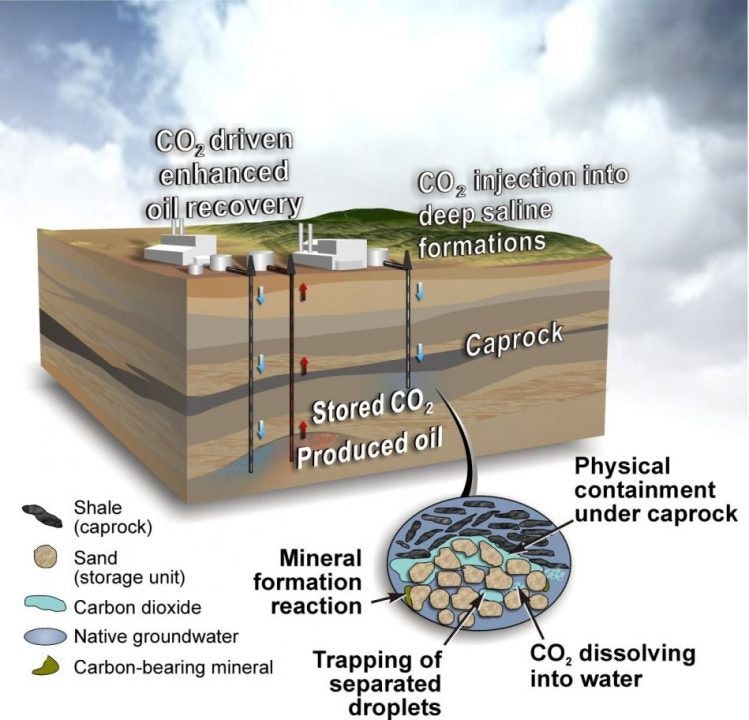- Solar energy blog
- What is carbon capture — and can it be a climate change solution?
What is carbon capture — and can it be a climate change solution?


Laura Rodríguez
Business developer
Laura is a renewable and software industry sales professional, currently working at RatedPower as Sales Overlay in North America & Territory Manager Oceania. With a background in International Business and International Trade, Laura previously worked in the business strategy area in various companies as well as as a market analyst for the Government of Spain in Australia.

Content
The global energy industry has undeniable links with carbon dioxide emissions, with coal, oil, and gas releasing a combined total of 32.45 billion tons of CO2 into the atmosphere in 2020.
Carbon capture and storage (CCS) provides a means of reducing harmful emissions: capturing the CO2 produced, transporting it, and then storing it deep underground. It’s a practice that not all energy industry professionals can get behind — in fact, carbon capture has come under intense criticism with many carbon capture projects deemed to be “expensive failures” and “Band-Aid solutions”.
In this post, we’re going to look at what carbon capture is, how it works, and whether or not the carbon capture process has potential for slowing climate change.
What is carbon capture?
According to the Center for Climate and Energy Solutions, “carbon capture can achieve 14 percent of the global greenhouse gas emissions reductions needed by 2050”. C2ES also defines carbon capture as “the only practical way to achieve deep decarbonization in the industrial sector”.
Carbon capture and storage can be used to define the range of technologies used to trap CO2 en masse once this carbon dioxide has already been produced by heavy-emitting power plants. It’s for this reason that critics of CCS believe the process is flawed — why focus on trapping carbon once it’s already been released rather than minimizing how harmful our energy production processes are at the source?

Source: California Air Resources Board.
In simple terms, carbon capture works by:
Capturing the carbon through a variety of different pre-combustion, post-combustion, or ‘Oxyfuel’ methods, each of which requires the use of gas (carbon monoxide and hydrogen, typically), chemical solvents, or fossil fuel combustion in order to facilitate capture. Post-combustion carbon capture is the method most commonly used at existing power plants.
Transporting captured carbon to a storage site via underground pipelines. In the US, for example, there are more than 4,500 miles of carbon capture pipelines and more will be needed across the world should CCS become more widespread.
Injecting the CO2 into geographical formations deep underground for permanent storage (around 98% of injected CO2 remains permanently trapped). These storage sites can be on- or off-shore; the ‘Endurance’ site used by UK energy companies can be found ~1.6km under the southern North Sea seabed, approximately 90km offshore.
The Global CCS Institute has described carbon capture and storage as “a proven technology that has been in safe operation for over 45 years”.
How is carbon capture being used in 2022?
The first CCS facility was opened in 1972 in Texas, USA. In the last fifty years, this site has captured and stored more than 200 million tons of CO2, contributing to the 73 million tonnes of CO2 captured and stored in 2020, as reported by HSBC.
But considering the collective global output we cited earlier (32.45 billion tons of CO2 in 2020) it’s clear that a handful of CCS sites will not be enough and if carbon capture is to be used as a climate-saving tool, we need more sites to be built.
In 2021, 51 carbon capture projects were announced in the US — a record number versus previous years. Below are just two examples of 21st-century CCS use cases and the carbon capture they’ve achieved.
Petra Nova Carbon Capture Project - Fort Bend County, Texas. Breaking ground in 2014, this project was seen as the biggest of its kind to date, expected to capture 1,600 thousand tonnes of CO2 each year by 2016 and then store it within sandstone 5,000 feet underground. At its peak, the Petra Nova project captured 90% of the CO2 emitted from the coal plant post-combustion. It later closed operations in 2020 as a result of increased oil costs brought on by the pandemic.
The Northern Lights project, Norway - This CCS project recently received backing from software juggernaut Microsoft, adding to the already impressive team of collaborators including Shell, Total, and Equinor. The site has been designed to process 1.5 million tons of liquid CO2 each year — amounting to more than 100 million over its lifecycle.

Is carbon capture an effective climate change solution?
The support for carbon capture outweighs the criticism, with both media publications and industry boards citing CCS as important “sources of hope” in the fight against climate change.
This is particularly true in the current energy landscape, where fossil fuels still provide more power across the world than renewable sources. When it comes to capturing the CO2 produced by harmful power generation — coal, oil, and gas — CCS certainly has a role to play. The more carbon dioxide we can capture and trap, the less will be emitted into the environment and contribute to climate damage. And for businesses that have signed the Paris Agreement, carbon capture and storage seem a viable solution and step forward.
At present, CCS is believed to be capable of capturing 90% of carbon dioxide emissions — leaving, of course, 10% still to be released into the atmosphere. In order to protect the environment as required, CCS efficiency will need improving and the rollout will need to be sped up.
CCS versus renewable energy
We mentioned how hotly debated CCS is and one of the main comparisons that industry professionals make is between carbon capture investments vs renewable energy production.
A 2019 report found that solar and wind energy plants represent better investments — with greater potential for long-term, environmentally friendly practices — when the cost to build turbines and panels is compared to the cost of building carbon capture equipment. The report also found that capturing carbon brought down the plant’s overall productivity, too.
Designing a greener future
If you are developing a solar power project, RatedPower platform can help you to optimize the project and establish the very best conditions for success. Contact us for more information and to start designing and greener future for your energy business.
Latest stories
Related posts
Technology and engineering
Innovation in renewable energy: Developments expected in 2025
We look at the 10 biggest renewable industry developments that are making a green future possible, including perovskite solar cells, green hydrogen, and more.
Updated 18 MAR, 25

Market analysis
Breaking down solar farm costs: Free template inside
Updated 27 SEP, 21

Market analysis
Solar energy in Australia: a 2021 market analysis
Updated 11 MAY, 21

- RatedPower
- Solar energy blog
- What is carbon capture — and can it be a climate change solution?
